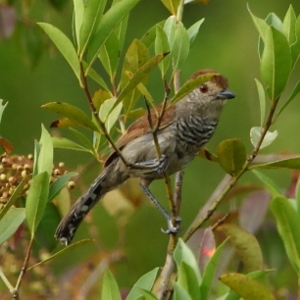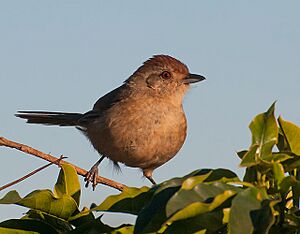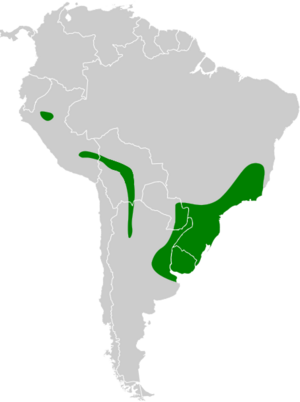Rufous-capped antshrike facts for kids
Quick facts for kids Rufous-capped antshrike |
|
|---|---|
 |
|
| Male at Bragança Paulista, São Paulo State, Brazil | |
 |
|
| Female at Timburi, São Paulo State, Brazil | |
| Conservation status | |
| Scientific classification | |
| Genus: |
Thamnophilus
|
| Species: |
ruficapillus
|
 |
|
The rufous-capped antshrike (Thamnophilus ruficapillus) is a cool bird that lives in South America. It's part of a group of birds called "typical antbirds." You can find this bird in several countries, including Argentina, Bolivia, Brazil, Paraguay, Peru, and Uruguay.
Contents
Bird Classification: How Scientists Group Birds
Scientists like to group animals to understand them better. This is called taxonomy. The rufous-capped antshrike got its scientific name, Thamnophilus ruficapillus, from a French scientist named Louis Pierre Vieillot in 1816.
This bird is very closely related to another bird called the rufous-winged antshrike. Some scientists are even thinking about combining them into one species!
There are five different types, or subspecies, of the rufous-capped antshrike. These are like different "versions" of the same bird, each with small differences and living in different areas. This article will talk about all five of these subspecies.
What Does the Rufous-Capped Antshrike Look Like?
The rufous-capped antshrike is about 15 to 17 centimeters (6 to 7 inches) long. It weighs between 16.3 and 25 grams (0.57 to 0.88 ounces). Birds in the Thamnophilus group are fairly large antbirds. They all have strong beaks with a hook, a bit like a shrike's beak.
This bird shows "sexual dimorphism," which means males and females look quite different.
Male and Female Antshrikes
The male rufous-capped antshrike has a reddish-brown cap on its head. Its face and throat are a light gray color, sometimes with faint dark spots. Its back is dark brown, and its wings are a reddish-brown. The tail is dark with white tips and bars. Its belly is mostly white with a bit of a yellowish tint, and it has black bars on its chest and sides.
Female rufous-capped antshrikes look similar to males but have a cinnamon-brown cap. Their tail is reddish-brown with no white markings. They also have very faint or no bars on their chest.
Subspecies Variations
The different subspecies have slight variations in their colors. For example, some males might have darker gray faces or more distinct bars on their bodies. Females also show differences, like some having more olive-colored backs or brighter yellow-brown bellies. These small differences help scientists tell the subspecies apart.
Where Does the Rufous-Capped Antshrike Live?
The rufous-capped antshrike lives in different areas that are not connected, which is called a "disjunct distribution." Each of the five subspecies lives in its own specific region.
Bird Homes and Habitats
This bird lives in various types of places depending on where it is found. In the Andes mountains of Peru and Bolivia, it likes semi-humid montane forests, secondary forests (forests that have grown back after being cut), and scrublands. It often hangs out at the edges of forests.
In lower areas of Brazil, Uruguay, Paraguay, and Argentina, it prefers isolated patches of shrubs and small trees. You can also find it in scrublands, hedgerows, and even at the edges of towns.
The bird can live at different heights, from sea level up to 2,400 meters (7,900 feet) in Brazil. In Peru, it lives higher, between 1,800 and 3,000 meters (5,900 and 9,800 feet). In Bolivia, it's found between 600 and 2,700 meters (2,000 and 8,900 feet).
Rufous-Capped Antshrike Behavior
Movement
Most rufous-capped antshrikes stay in the same area all year long. However, some birds in the very southern parts of their range might move north during the winter months.
Feeding Habits
We don't know all the details about what the rufous-capped antshrike eats, but it mainly eats insects. It also eats some fruits.
This bird usually looks for food alone or in pairs. It mostly forages low to the ground, usually within 2 meters (7 feet) of the ground, but sometimes as high as 7 meters (23 feet). It hops through plants, picking insects off leaves, stems, and branches. Sometimes, it even drops to the ground to grab prey from fallen leaves.
Reproduction and Life Cycle
Scientists don't know much about how the "northern" subspecies of this bird breed. However, the "southern" subspecies breed from October to February, though the exact timing can vary a bit by region.
The nest is shaped like a cup and is made of plant fibers and small roots. It's usually hung in a fork of a tree branch. The main subspecies lays three eggs, but sometimes only two. We don't know how long the eggs take to hatch or when the young birds leave the nest.
Interestingly, in Argentina, a bird called the shiny cowbird sometimes lays its eggs in the rufous-capped antshrike's nest. This is called nest parasitism, where the cowbird tricks the antshrike into raising its young.
Bird Songs and Calls
The song of the rufous-capped antshrike seems to change a bit depending on the region, but scientists haven't studied this much yet. People have described its song as a series of 12-15 "tjew" notes that get a little faster.
Its calls also vary. They can include an "upslurred whistle," a "loud, rough 'chirr'," a "low, rough snarl," and a "rising whine." You can listen to some of its sounds online!
Conservation Status: Is the Bird Safe?
The IUCN (International Union for Conservation of Nature) has looked at the rufous-capped antshrike's status. They consider both the "northern" and "southern" populations to be of "Least Concern." This means they are not currently in danger of disappearing.
Even though their exact population size isn't known, scientists believe the numbers are slowly going down. However, no immediate threats have been found. This bird is quite common in most places it lives, though it's a bit rare in Paraguay and northern Peru. It lives in several protected areas in Brazil and Argentina.
Because this bird can use shrubby areas, forest edges, and other places where forests have grown back, it's not very sensitive to changes in its environment. This helps it survive even when its habitat is disturbed.


